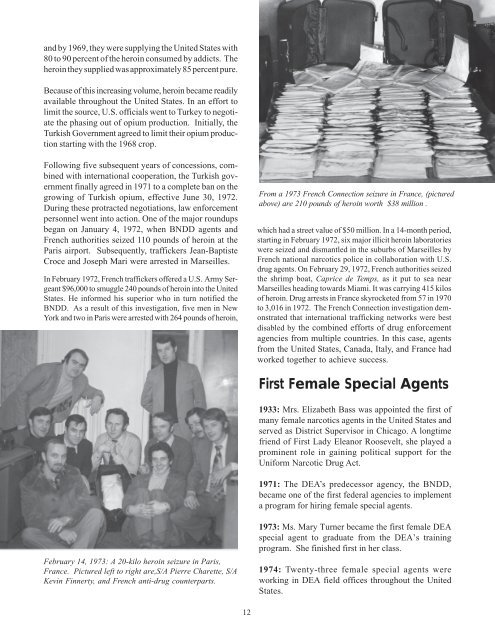Download This File - The Free Information Society
Download This File - The Free Information Society
Download This File - The Free Information Society
Create successful ePaper yourself
Turn your PDF publications into a flip-book with our unique Google optimized e-Paper software.
and by 1969, they were supplying the United States with<br />
80 to 90 percent of the heroin consumed by addicts. <strong>The</strong><br />
heroin they supplied was approximately 85 percent pure.<br />
Because of this increasing volume, heroin became readily<br />
available throughout the United States. In an effort to<br />
limit the source, U.S. officials went to Turkey to negotiate<br />
the phasing out of opium production. Initially, the<br />
Turkish Government agreed to limit their opium production<br />
starting with the 1968 crop.<br />
Following five subsequent years of concessions, combined<br />
with international cooperation, the Turkish government<br />
finally agreed in 1971 to a complete ban on the<br />
growing of Turkish opium, effective June 30, 1972.<br />
During these protracted negotiations, law enforcement<br />
personnel went into action. One of the major roundups<br />
began on January 4, 1972, when BNDD agents and<br />
French authorities seized 110 pounds of heroin at the<br />
Paris airport. Subsequently, traffickers Jean-Baptiste<br />
.Croce and Joseph Mari were arrested in Marseilles.<br />
In February 1972, French traffickers offered a U.S. Army Sergeant<br />
$96,000 to smuggle 240 pounds of heroin into the United<br />
States. He informed his superior who in turn notified the<br />
BNDD. As a result of this investigation, five men in New<br />
York and two in Paris were arrested with 264 pounds of heroin,<br />
February 14, 1973: A 20-kilo heroin seizure in Paris,<br />
France. Pictured left to right are,S/A Pierre Charette, S/A<br />
Kevin Finnerty, and French anti-drug counterparts.<br />
12<br />
From a 1973 French Connection seizure in France, (pictured<br />
above) are 210 pounds of heroin worth $38 million .<br />
which had a street value of $50 million. In a 14-month period,<br />
starting in February 1972, six major illicit heroin laboratories<br />
were seized and dismantled in the suburbs of Marseilles by<br />
French national narcotics police in collaboration with U.S.<br />
drug agents. On February 29, 1972, French authorities seized<br />
the shrimp boat, Caprice de Temps, as it put to sea near<br />
Marseilles heading towards Miami. It was carrying 415 kilos<br />
of heroin. Drug arrests in France skyrocketed from 57 in 1970<br />
to 3,016 in 1972. <strong>The</strong> French Connection investigation demonstrated<br />
that international trafficking networks were best<br />
disabled by the combined efforts of drug enforcement<br />
agencies from multiple countries. In this case, agents<br />
from the United States, Canada, Italy, and France had<br />
worked together to achieve success.<br />
First Female Special Agents<br />
1933: Mrs. Elizabeth Bass was appointed the first of<br />
many female narcotics agents in the United States and<br />
served as District Supervisor in Chicago. A longtime<br />
friend of First Lady Eleanor Roosevelt, she played a<br />
prominent role in gaining political support for the<br />
Uniform Narcotic Drug Act.<br />
1971: <strong>The</strong> DEA’s predecessor agency, the BNDD,<br />
became one of the first federal agencies to implement<br />
a program for hiring female special agents.<br />
1973: Ms. Mary Turner became the first female DEA<br />
special agent to graduate from the DEA’s training<br />
program. She finished first in her class.<br />
1974: Twenty-three female special agents were<br />
working in DEA field offices throughout the United<br />
States.

















